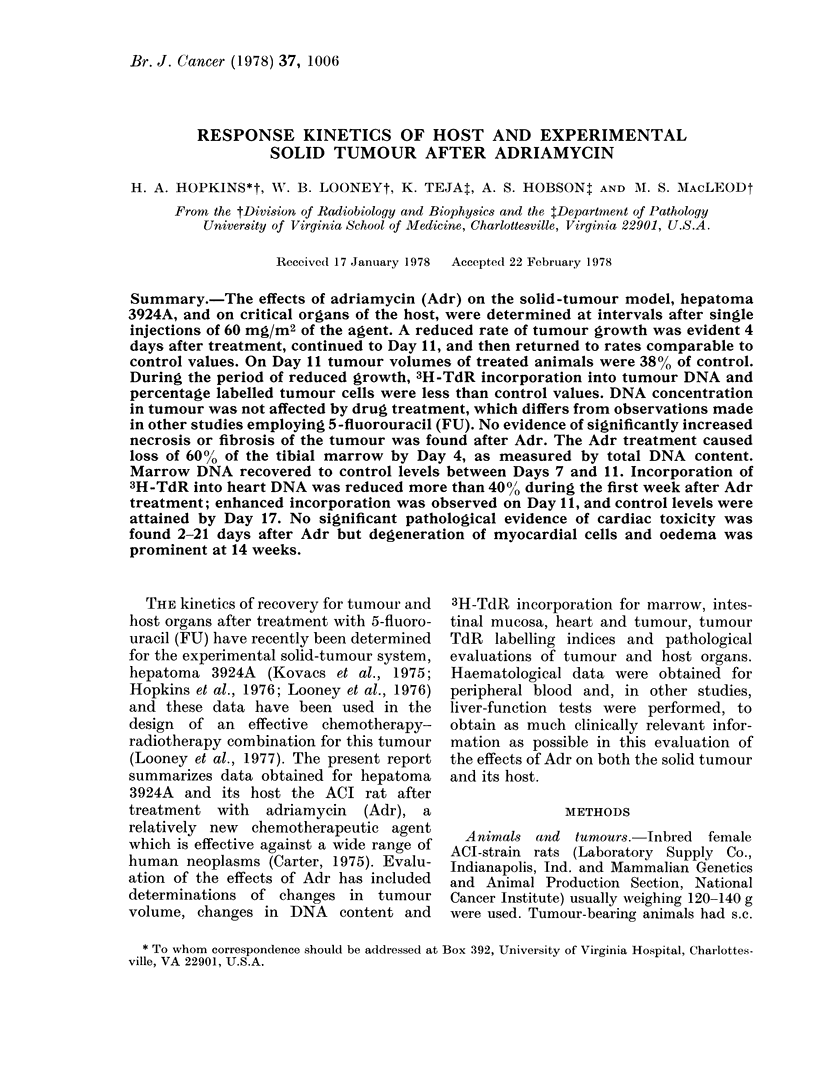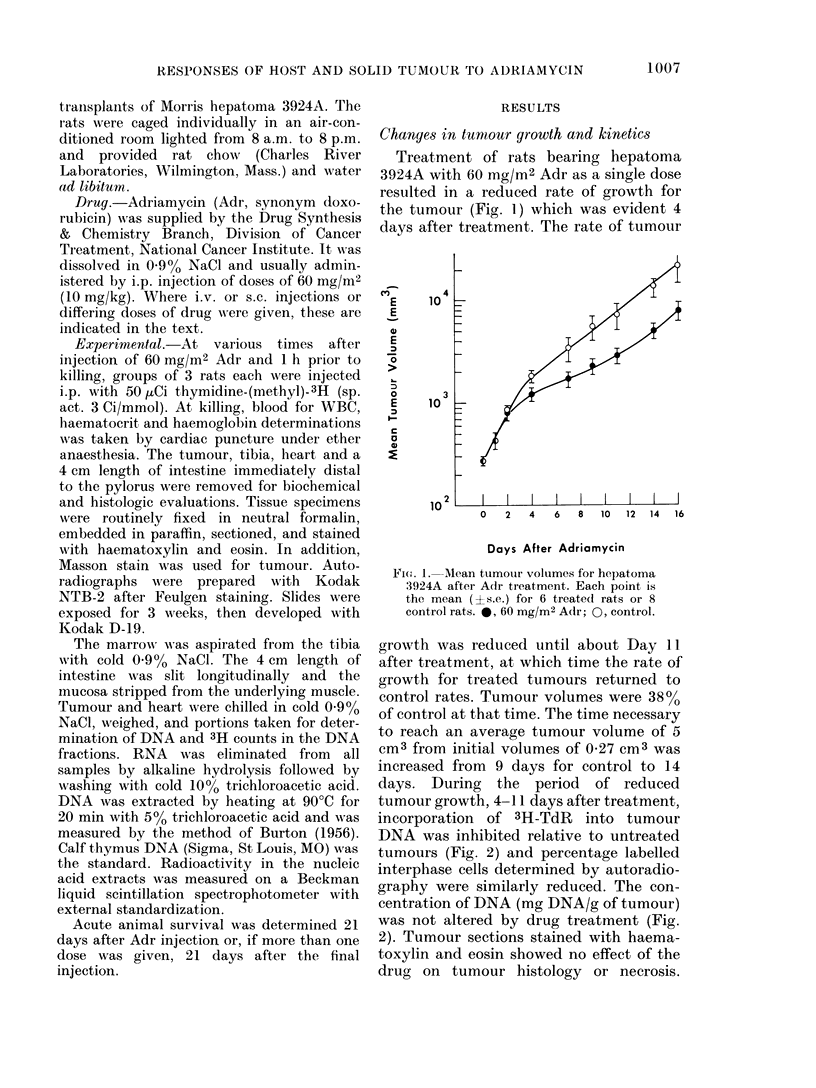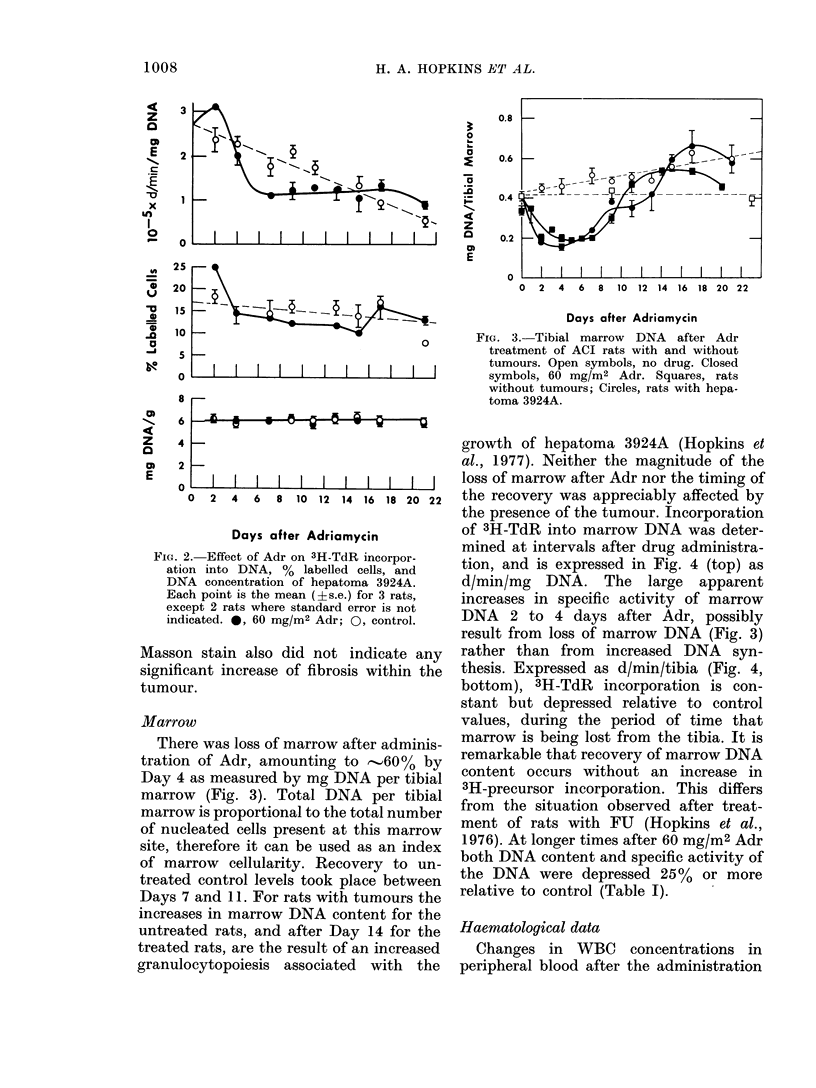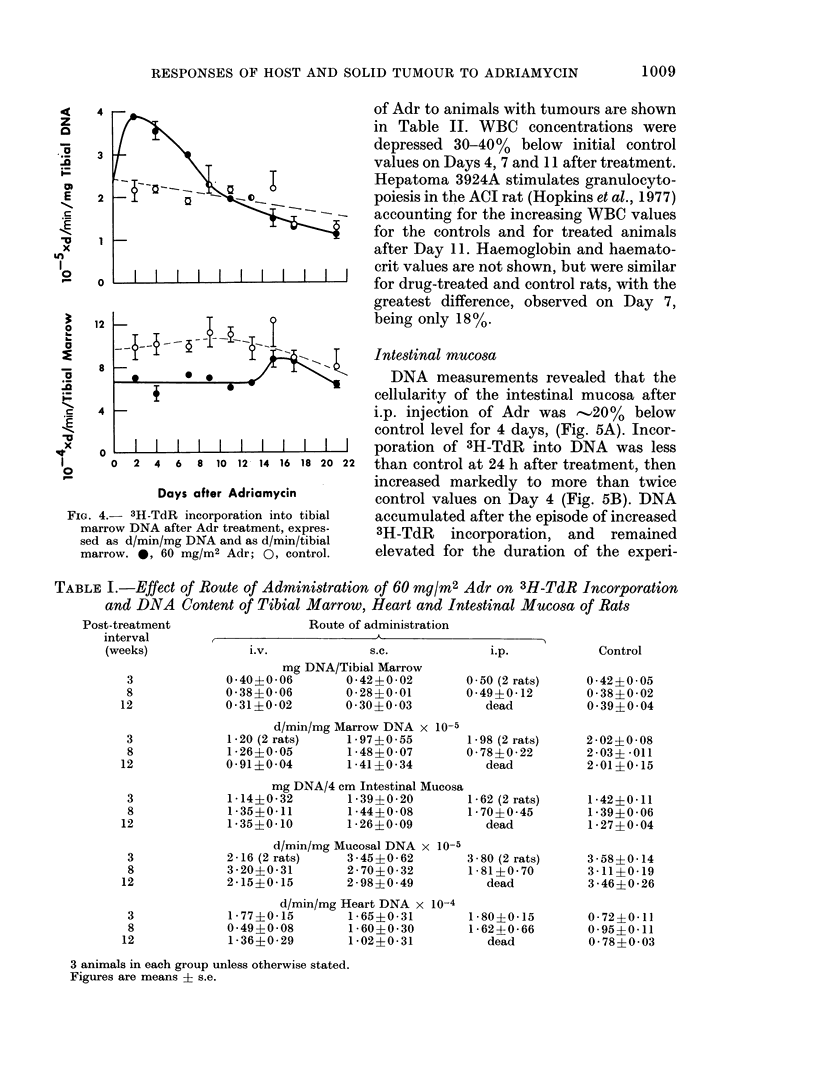Abstract
The effects of adriamycin (Adr) on the solid-tumour model, hepatoma 3924A, and on critical organs of the host, were determined at intervals after single injections of 60 mg/m2 of the agent. A reduced rate of tumour growth was evident 4 days after treatment, continued to Day 11, and then returned to rates comparable to control values. On Day 11 tumour volumes of treated animals were 38% of control. During the period of reduced growth, 3H-TdR incorporation into tumour DNA and percentage labelled tumour cells were less than control values. DNA concentration in tumour was not affected by drug treatment, which differs from observations made in other studies employing 5-fluorouracil (FU). No evidence of significantly increased necrosis or fibrosis of the tumour was found after Adr. The Adr treatment caused loss of 60% of the tibial marrow by Day 4, as measured by total DNA content. Marrow DNA recovered to control levels between Days 7 and 11. Incorporation of 3H-TdR into heart DNA was reduced more than 40% during the first week after Adr treatment; enhanced incorporation was observed on Day 11, and control levels were attained by Day 17. No significant pathological evidence of cardiac toxicity was found 2-21 days after Adr but degeneration of myocardial cells and oedema was prominent at 14 weeks.
Full text
PDF








Selected References
These references are in PubMed. This may not be the complete list of references from this article.
- BURTON K. A study of the conditions and mechanism of the diphenylamine reaction for the colorimetric estimation of deoxyribonucleic acid. Biochem J. 1956 Feb;62(2):315–323. doi: 10.1042/bj0620315. [DOI] [PMC free article] [PubMed] [Google Scholar]
- Belli J. A., Piro A. J. The interaction between radiation and adriamycin damage in mammalian cells. Cancer Res. 1977 Jun;37(6):1624–1630. [PubMed] [Google Scholar]
- Byfield J. E., Lee Y. C., Tu L. Molecular interactions between adriamycin and x-ray damage in mammalian tumor cells. Int J Cancer. 1977 Feb 15;19(2):186–193. doi: 10.1002/ijc.2910190208. [DOI] [PubMed] [Google Scholar]
- Carter S. K. Adriamycin-a review. J Natl Cancer Inst. 1975 Dec;55(6):1265–1274. doi: 10.1093/jnci/55.6.1265. [DOI] [PubMed] [Google Scholar]
- Clarkson J. M., Humphrey R. M. The effect of adriamycin on cell cycle progression and DNA replication in chinese hamster ovary cells. Cancer Res. 1977 Jan;37(1):200–205. [PubMed] [Google Scholar]
- Hopkins H. A., Kovacs C. J., Looney W. B., Wakefield J. A. Differential recovery of intestine, bone marrow, and thymus of rats with solid tumors following 5-fluorouracil administration. Cancer Biochem Biophys. 1976;1(6):303–312. [PubMed] [Google Scholar]
- Hopkins H. A., Kovacs C. J., Looney W. B., Wakefield J. A., Hobson A. S., Morris H. P. Cell proliferation in organs of rats bearing hepatoma 3924A: effects of X-rays of surgery. Cancer Biochem Biophys. 1977;2(1):11–17. [PubMed] [Google Scholar]
- Hopkins H. A., Looney W. B. Synchronization of host and tumor responses for sequential therapy in experimental solid tumors. Antibiot Chemother (1971) 1978;23:135–147. doi: 10.1159/000401479. [DOI] [PubMed] [Google Scholar]
- Kim S. H., Kim J. H. Lethal effect of adriamycin on the division cycle of HeLa cells. Cancer Res. 1972 Feb;32(2):323–325. [PubMed] [Google Scholar]
- Kovacs C. J., Hopkins H. A., Simon R. M., Looney W. B. Effects of 5-fluorouracil on the cell kinetic and growth parameters of hepatoma 3924A. Br J Cancer. 1975 Jul;32(1):42–50. doi: 10.1038/bjc.1975.132. [DOI] [PMC free article] [PubMed] [Google Scholar]
- Lenaz L., Page J. A. Cardiotoxicity of adriamycin and related anthracyclines. Cancer Treat Rev. 1976 Sep;3(3):111–120. doi: 10.1016/s0305-7372(76)80018-7. [DOI] [PubMed] [Google Scholar]
- Looney W. B., Trefil J. S., Hopkins H. A., Kovacs C. J., Ritenour R., Schaffner J. G. Solid tumor models for assessment of different treatment modalities: therapeutic strategy for sequential chemotherapy with radiotherapy. Proc Natl Acad Sci U S A. 1977 May;74(5):1983–1987. doi: 10.1073/pnas.74.5.1983. [DOI] [PMC free article] [PubMed] [Google Scholar]
- Looney W. B., Trefil J. S., Schaffner J. G., Kovacs C. J., Hopkins H. A. Solid tumor models for the assessment of different treatment modalities: systematics of response to radiotherapy and chemotherapy. Proc Natl Acad Sci U S A. 1976 Mar;73(3):818–822. doi: 10.1073/pnas.73.3.818. [DOI] [PMC free article] [PubMed] [Google Scholar]
- Mettler F. P., Young D. M., Ward J. M. Adriamycin-induced cardiotoxicity (cardiomyopathy and congestive heart failure) in rats. Cancer Res. 1977 Aug;37(8 Pt 1):2705–2713. [PubMed] [Google Scholar]
- Vahlsing H. L., Feringa E. R., Britten A. G., Kinning W. K. Dental abnormalities in rats after a single large dose of cyclophosphamide. Cancer Res. 1975 Aug;35(8):2199–2202. [PubMed] [Google Scholar]
- Zajicek G. The rodent incisor tooth proliferon. Cell Tissue Kinet. 1976 May;9(3):207–214. doi: 10.1111/j.1365-2184.1976.tb01268.x. [DOI] [PubMed] [Google Scholar]


